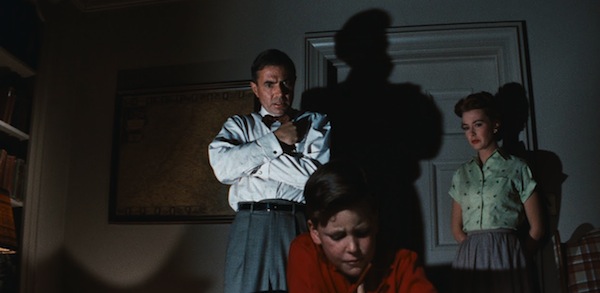Bigger Than Life demonstrates how quickly the American dream can crumble under pressure.
Bigger Than Life
Iconoclastic director Nicholas Ray may be best known for Rebel without a Cause, but some of his most interesting films are the lesser-known ones that found the director’s auteurial tendencies straining against the restrictions of the studio system he was born into. Had he come into the prime of his career 20 years later, one wonders what he might have been capable of in the New Hollywood of the ’70s. His 1956 film Bigger Than Life, released the year after Rebel, doesn’t really qualify as lesser-known any more, having gained many fans in the years following its initial flop. Jean-Luc Godard once rated it among the top ten sound films that the US ever produced.
On the surface, the film seems almost like a exploitation melodrama, with James Mason playing a family man given a prescription for a mysterious new drug—cortisone—that he becomes addicted to. The drug eventually drives him completely mad, nearly destroying his entire family. The alarmist overtones are really a cover for a much more complex film underneath, just as the baroque soap-opera sheen of Douglas Sirk’s films hid the pointed sociological critiques within. Ray’s film takes on the cookie-cutter banality of 1950s suburbia; the inflated specter of cortisone addiction, while based on a New Yorker medical article, is really just a device to show how readily the façade of the American dream collapses under the slightest duress.
While it’s not really obscure, the film is every bit the masterpiece that Rebel Without a Cause is, even if it’s never mentioned in the same breath. After watching it, you’ll initially wonder how it could have escaped wide acclaim for so long. But in retrospect, it’s no wonder audiences in 1956 weren’t ready for the film: It’s a disturbing, fractured mirror held up to show the fragility of everything they held to be most valuable.
View the trailer. Sunday at 2:00 and 4:30 p.m. at the National Gallery of Art. Free.
Summer Film Series at The Atlas
The Atlas Performing Arts Center unveils a huge 40-film summer screening series starting this Thursday, and then continuing into September with films every evening Thursday through Sunday. Each of those days will be devoted to a different category.
Thursdays it’s “Gay 101,” with 11 films on LGBT subjects. This week starts with Blake Edwards’ hilarious 1982 classic, Victor Victoria, which stars Julie Andrews as a hard-up-for-work singer who devises a scheme to pretend to be a man pretending to be a woman in a new lounge act. Her gay friend Toddy poses as her lover to make it more convincing that she’s really a man.
Fridays are musical nights, starting this week with the 1963 Dick Van Dyke and Ann-Margret Olsson vehicle, Bye Bye Birdie. The film is loosely inspired by Elvis Presley’s conscription, with Van Dyke playing a songwriter who cooks up a scheme to make his own name by writing a song for a Presley-like character to sing on the Ed Sullivan show right before heading off to war.
Saturdays bring the family series, kicking off with the animated immigrant mice of An American Tail.
Finally, Sundays are devoted to Spike Lee, with a series mostly concentrating on his pre-1996 output, apart from this weekend’s first film, 2006’s Denzel Washington/Clive Owen heist movie, Inside Man.
View the trailer for Victor Victoria. Starts Thursday at the Atlas Performing Arts Center and continues through early September with programs Thursday through Sunday weekly. Check the schedule for complete listings. Free.

Cars 2
Despite its reputation as a middle-of-the-road Pixar title in terms of gross and its near-the-bottom-of-the-pack status in terms of critical reception, Cars is the film from the studio that has most lent itself to merchandising. So it should come as no surprise that they’re going back to that well, even if few were clamoring for continued automotive adventures as they might have for Toy Story sequels.
Directors John Lasseter and Brad Lewis leave behind the nostalgic theme of classic Americana that defined the first film in favor of, improbably perhaps, a spy movie. Lightning McQueen and Mater (Owen Wilson and Larry the Cable Guy) from the first film head abroad to compete in the World Grand Prix, but somewhere along the way, Mater—a rusty old tow truck—managed to become embroiled in international espionage that distracts him from Lightning’s racing aspirations. Michael Caine, John Turturro, and Emily Mortimer all lend their voices to the film.
View the trailer. Opens Friday in theaters all over the area.
Conan O’Brien Can’t Stop
When Conan O’Brien stepped down from The Tonight Show after refusing to accept being pushed back to midnight, his severance from the network stipulated that he was legally prohibited from appearing on television for a certain period of time. O’Brien, who, as this documentary demonstrates over and over again, can’t stand inactivity, quite logically embarked on a live tour that he called the “Legally Prohibited from Being Funny on Television Tour.” The show was a multi-media comedy and music extravaganza, which found Conan playing ringleader to a traveling circus of songs, dance numbers, standup, and stories about his departure from his dream job.
What’s fascinating is that the portrait that emerges is of a man who, on the road, discovers that he has discovered a new dream job, even as he simultaneously comes to the realization that this particular job would kill him if he had to do it any longer than a few months. Fatigued not so much by the grind of the road, but by his unbounded love for his fans and friends. The inability to say no to his admirers when they ask for time, autographs, and photographs wears him out. The film is an entertaining look and gives the rare opportunity to see O’Brien’s personality in ways that can never come across on television.
View the trailer. Opens Friday at E Street Cinema.
Mildred Pierce
With Todd Haynes’s recent miniseries adaptation of James M. Cain’s novel about a Depression-era housewife trying to support her children complete, now seems like a good time to revisit the original 1945 adaptation. Unlike Haynes’s version, which was a sprawling and detailed look at the social conventions of 1930s America, Michael Curtiz’s take—scripted in part by William Faulkner—is tense film noir that centers around the murder that opens the film: of Monte Beragon, Mildred Pierce’s second husband.
After starting at the end, the film backtracks to show everything leading up to the event. Joan Crawford is fantastic in one of her signature roles, and the inky shadows of Ernest Haller’s stark black and white cinematography deepen the mounting dread beautifully. While the story may be familiar, this is an entirely different take on the material, and fascinating to watch with the modern take fresh in your mind.
View the trailer. Thursday at 6:30 p.m. at the Smithsonian American History Museum. Free.
To the Limit
German director Pepe Danquart made a trilogy of sports movies between 1999 and 2007 on biking, hockey, and mountain climbing. The Goethe-Institut is screening all three over the next three weeks, starting with the most recent, the climbing film To the Limit. Danquart focuses on a pair of climbing brothers who are looking to break a speed climbing record at El Capitan, a 3,000-foot vertical rock wall in Yosemite National Park, one of climbing’s greatest challenges. The Huber brothers look to scale the wall in two and a half hours—for a climb that most mountaineers spend multiple days attacking. Danquart gets spectacular, and vertigo-inducing footage of the pair going up the wall, as well as interviews on the ground about their fascination with the sport.
View the trailer. Monday at 6:30 p.m. at the Goethe-Institut. $7.
Blu-ray Pick of the Week: The Adjustment Bureau
Screenwriter George Nolfi’s directorial debut befuddled the marketing team at Universal, who seemed unsure whether to market it as a political thriller, a romance, or science fiction. But even buried in the cold cinematic wastelands of February, The Adjustment Bureau still managed to be a modest success, owing to the word of mouth generated by the film’s deft blend of those genres, and the undeniable chemistry of Matt Damon and Emily Blunt in the lead roles. Even if it was difficult to tell exactly what kind of movie it was from the trailers and television ads, the way these two actors play so well off of one another was immediately apparent.
Based very loosely on a Phillip K. Dick short story that the film improves on vastly, Damon plays a young political phenom who’s public career is sunk by a badly timed mountain-out-of-a-molehill scandal, but on election night his disappointment is tempered by a meeting with a mysterious and beautiful stranger. As it turns out, her presence there was arranged by the titular Bureau, a group that essentially amounts to angels pulling the strings of fate to make sure important events fall where they should. When the pair meet again, it’s against The Plan, and the film becomes a fast paced, thrilling love story about the nature of fate and true love. Damon and Blunt sell the profound connection required many times over.
Special Features: Commentary with writer/director George Nolfi, three behind-the-scenes featurettes, a half-dozen deleted/extended scenes, and a special Google-maps-integrated interactive feature that allows you to explore the network of portals used by the Bureau to travel around New York City.
Subscribe to Washingtonian
Follow Washingtonian on Twitter
More>> After Hours Blog | Arts & Events | Happy Hour Finder | Calendar of Events
















